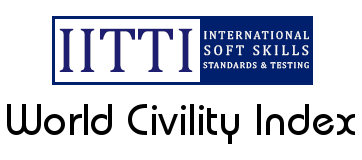This is a revision of the initial official Level 1 Learning Outcomes document
(ref: Level1_LearningOutcomes_official_Sep18_2012.doc)
Oct 19, 2012 from Patrick
I have revised the official Level 1 Learning Outcomes based on your input.
In order to make it "look better", the official publication in PDF format will have everything in black;
readers won't be able to tell the latest changes.
I have included a working copy in DOC format where the changes from the last edition are highlighted in
red
.
 Level 1 Learning Outcomes rev. 1 Working Copy
Level 1 Learning Outcomes rev. 1 Working Copy
Oct 21, 2012 from Lynne
Bravo for the additions to complete the LO's. This seems quite an extensive body of knowledge.
Just to be crystal clear can we categorize dresses something like:
|
Formal- Tailored dress and jacket, solid colour or small patterns
Semi-Formal- Long sleeved tailored dresses, solid colour or small patterns
Casual- Sleeveless and short sleeved dresses, solid colour or small to medium patterns
|
Oct 22, 2012 from Patrick
Thanks for the re-verification. I discovered something missing in our document.
(1) I have added the word "solid" to the colour description.
(Currently the document just says "neutral" colour for formal attire.)
I think this additional word is important.
(2) Also the current document says "larger" prints for casual wear;
I have now added further clarification of "small to medium" to quantify the size.
(3) In trying to cut down on repetition for semi-formal attire,
I have added "Everything same as formal attire except as noted below".
So the total descriptions are as follows:
|
Formal -
|
tailored dress and jacket (page 5)
solid colours (page 5)
small patterns (page 5)
|
|
Semi-Formal -
|
tailored (page 6)
long-sleeved dress (page 7)
solid colours (same as formal attire on page 6)
small patterns (same as formal attire on page 6)
|
|
Casual -
|
sleeveless and short-sleeved dresses (page 7)
larger (small to medium) patterns (page 7)
|
I have replaced Revision 1 with adding the two new changes in a Revision 2 edition at the same location in our intranet.
Thanks for your detailed feedback!
 Level 1 Learning Outcomes rev. 2 Working Copy
Level 1 Learning Outcomes rev. 2 Working Copy
Oct 22, 2012 from Patrick
To make it more complete, I have made a summary about tights, court shoes and dresses.
Some of the details about dresses are already in Level 1 from earlier editions,
and I have highlighted what are newly added in red below.
Additional details that are proposed to go into Level 2 are in blue.
(Referenced are from Learning Outcomes, Sep18,2012 rev 2 edition)
|
Formal -
|
- tailored dress and jacket (as on page 5)
- blouse: silk (as on p11)
or silk like (i.e. high-quality man-made fabrics) (Level 2)
- fine "sheer" hosiery (added on p12)
- closed-toed pumps (as on p8)
|
|
Semi-Formal -
|
- tailored dress with long sleeves (added on p7)
- blouse: polyester, cotton, less expensive materials (Level 2)
- no hosiery in hot countries or in summer
(Hosiery may be required in some industries) (Level 2)
- groomed legs and feet (Level 2)
- closed-toed pumps (as on p8)
|
|
Casual -
|
- short sleeved or sleeveless dress (added on p7)
- blouse: cotton, lycra top, nylon (Level 2)
- lower cut dresses not showing cleavage (as on p13)
- larger (small to medium) print dresses (added on p7)
- hot countries and in summer, no hosiery, groomed legs and feet (Level 2)
|
(Level 2)
TERMS
Court shoes =
In the UK, closed-toed pumps or a simple business shoe with a heel.
In the US, athletic shoes worn to play tennis.
Tights =
In the UK, hosiery (20 denier for very fine, 60 denier is almost opaque).
The lower the number, the finer the gauge or the more sheer.
In the US, tights refer to a heavier, opaque pantyhose, sheer hosiery refers to a fine-denier hose.
Please let me know if some of the Level 2's should be in Level 1, or vice versa.
Lynne's response (Sep23,2012):
I see all these details going into Level 1. To me, they are all basic concepts of business appearance.
Hi Lynne, Do you mean "I see all these details going into Level 2"?
(I do agree it would be quite fragmented if there are pieces of information scatter across levels.)
Lynne's response (Sep24,2012):
Did I get the terms wrong?
Anyway,
I thought level 1 was the first level! If the first ET exam people take tests all the basic information on appearance I would include all the information on fabrics,
dresses and business attire details in this basic level.
As you say, there wouldn't be any point in scattering the basic information over levels.
I think that our second level needs to be more on application and analysis, rather than basic information.
Oops! I think I misunderstood your original email!
I agree with you absolutely here.
If everybody else agrees,
all the blue stuff (see above) can be re-categorized into Level 1.
This will keep the discussion on wardrobe all packaged neatly in Level 1.
(And I don't think it would be too much stuff for Level 1.)
Oct 23, 2012 from Riet
Great work.
However, I would prefer "neutral" instead of "solid" when we speak about color,
because this is the common language in our field and internationally better understood, to my opinion.
I had to look in the dictionary for the meaning of "solid",
and found that I needed a lot of interpretation to understand that solid means serious(?),
but then to translate this into specific colours one needs to know more.
Of course, as always, I am open to any opinion that shows me I don't see it right.
Oct 23, 2012 from Kimberly
I think there is still some confusion here regarding dresses.
I did some fiddling below to add clarification.
I struggled with some of the wording. Let me know if this makes sense to you. Thanks
Formal attire seems clear -
| |
(Page 5 in Learning Outcomes)
Matching / Neutral, Solid Colours / Dark Light Contrast
- Most formal work attire is:
- For women: Skirt Suit, Pant Suit, Matching Jacket & Dress
|
I agree that this addition makes sense
-----------------------
Semi-formal needs clarification for dresses.
I also added '3/4 length sleeve' for dresses in semi-formal and informal category (in blue).
| |
(Page 6 in Learning Outcomes)
- Always includes a tailored style jacket
(exception for women: long sleeved, 3/4 length sleeved tailored style dress may be worn without a jacket)
|
-----------------------
[For informal attire] this makes sense to me, except that I added 3/4 length sleeve for more formal (in blue).
|
(Page 7 in Learning Outcomes)
For women:
|
| |
More formal
Collared shirt, sweater/blouse/dress
Long sleeve,
3/4 length sleeve
Coordinating vest or cardigan
Pressed/ironed slacks
| |
Less formal
No collar,
short-sleeved or
sleeveless
Dark denim jeans or corduroy if permitted
Larger (small to medium) print dresses
|
- Tailored Bottoms with a coordinating collared shirt
(blouse, sweater, top for women
or dress worn alone) are best when:
- your company is informal
- it fits with the client's company culture or style of dress
- you want to appear accessible, approachable, informal or relaxed
- you need functional clothing
- you are attending casual business socials, off-site retreats,
or casual time at conventions
- entry level job interviews for a company with an informal dress policy
that does not require a tailored jacket
Oct 23, 2012 from Christina
In response to Lynne, I'm not certain that "neutral" is a better word to "solid."
I think of neutral COLOURs with the word neutral.
I can't think of an alternative but have been using "solid" to mean plain one colour with no prints.
Oct 23, 2012 from Lynne
I love the term "wardrobe neutrals" meaning basic colours such as black, navy , brown, etc.
But actually that has a different meaning to solid meaning without pattern.
The other UK term used is "plain",
also meaning without pattern so it would make sense that Singapore uses that word too.
All things considered I think "solid" describes what we mean best by "no pattern"
and we can also describe the word as well.
Oct 25, 2012 from Christina
With the exception of the word "less expensive materials" under Semi-Formal dress, I'm fine with the rest.
I suggest we delete "less expensive material" altogether to avoid the confusion that more expensive materials,
such as a high fashion branded item, are more formal.



